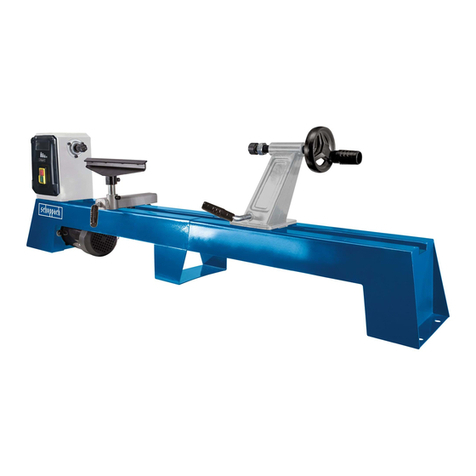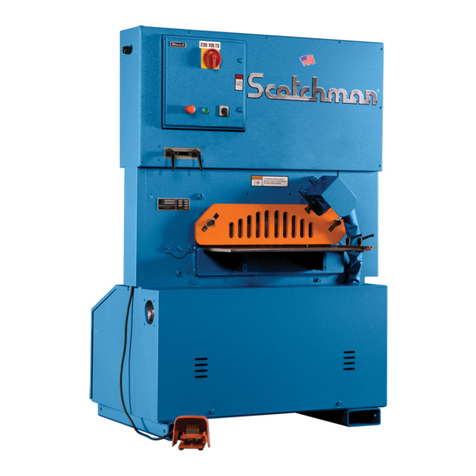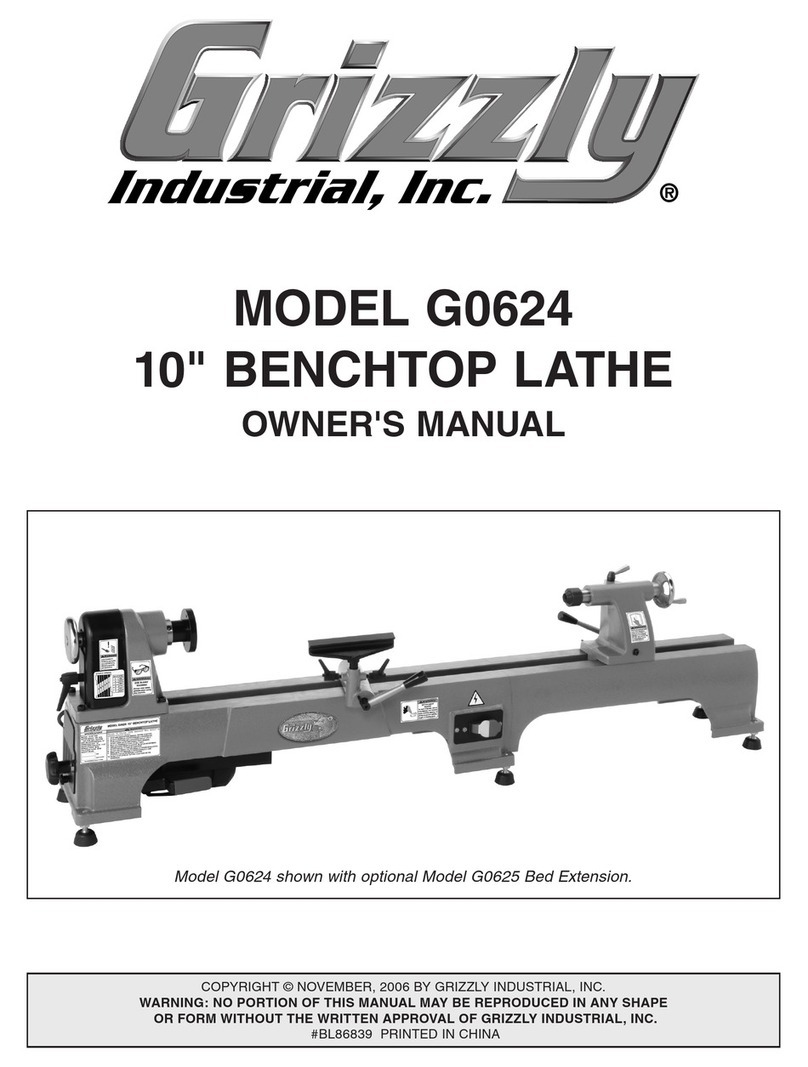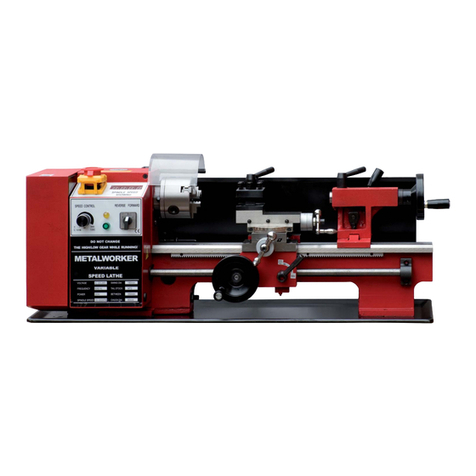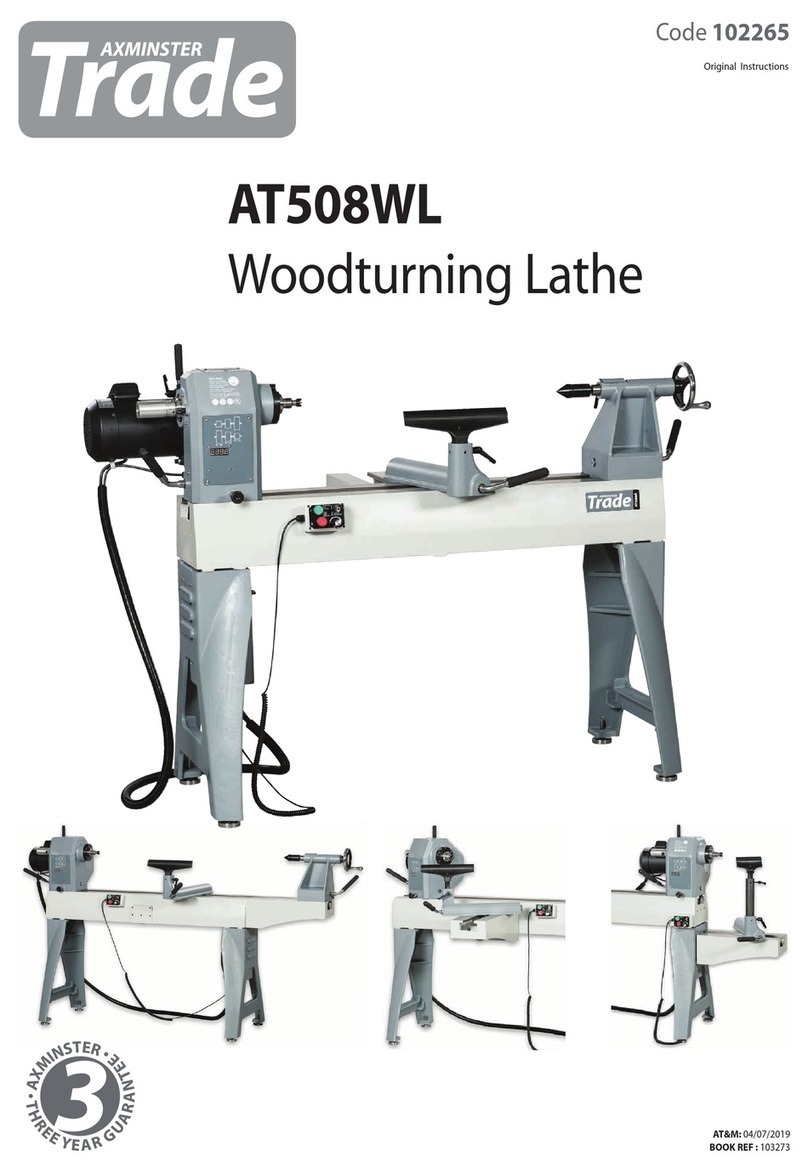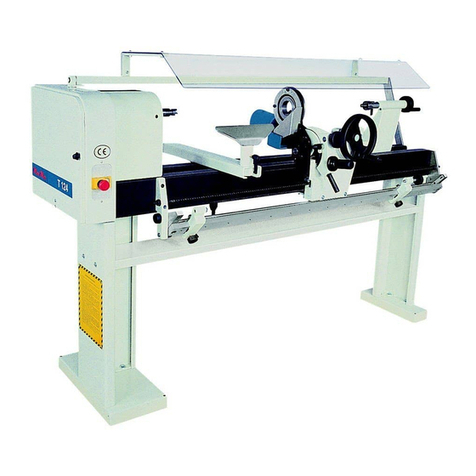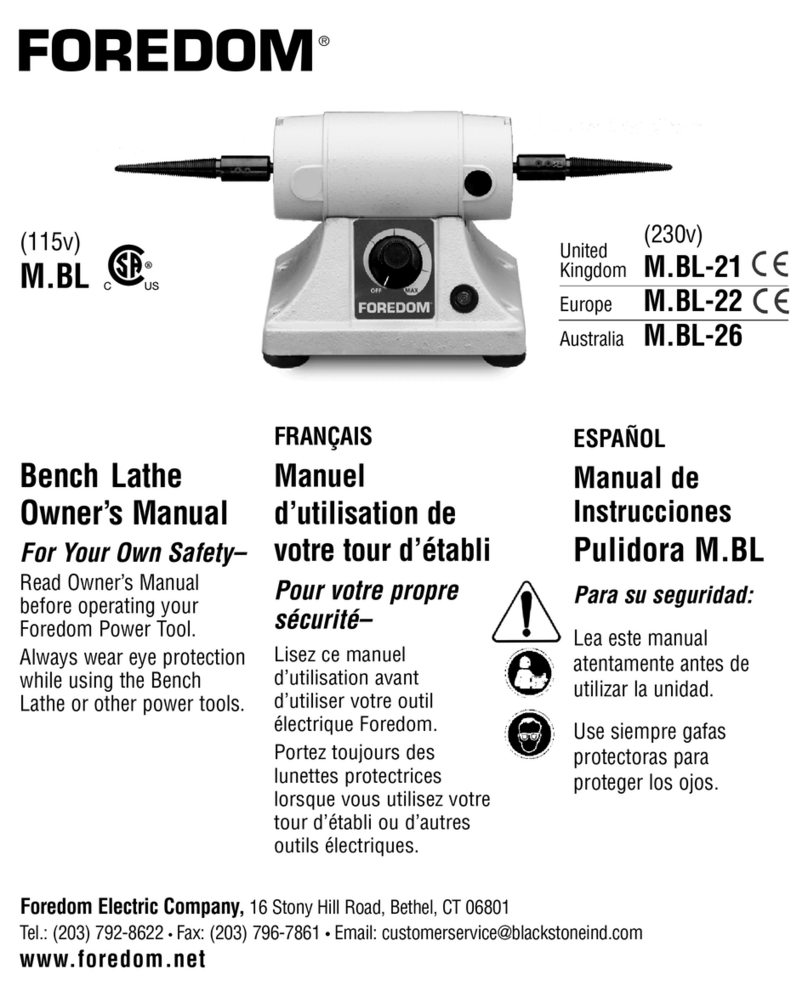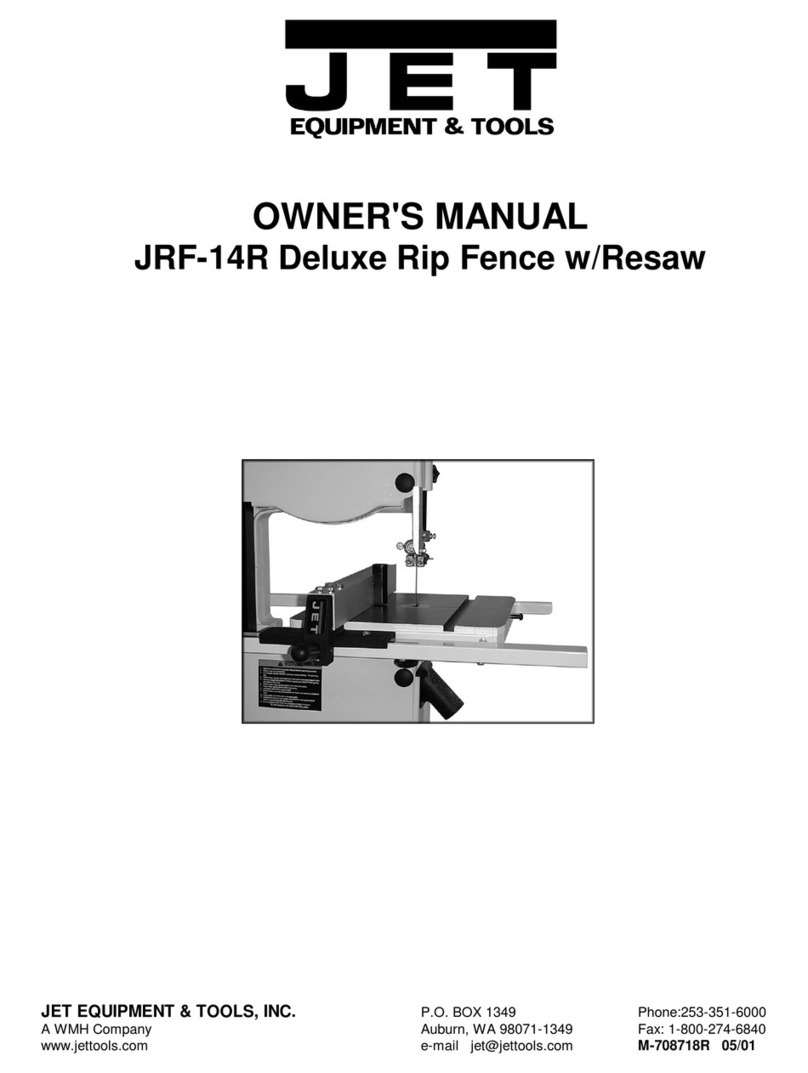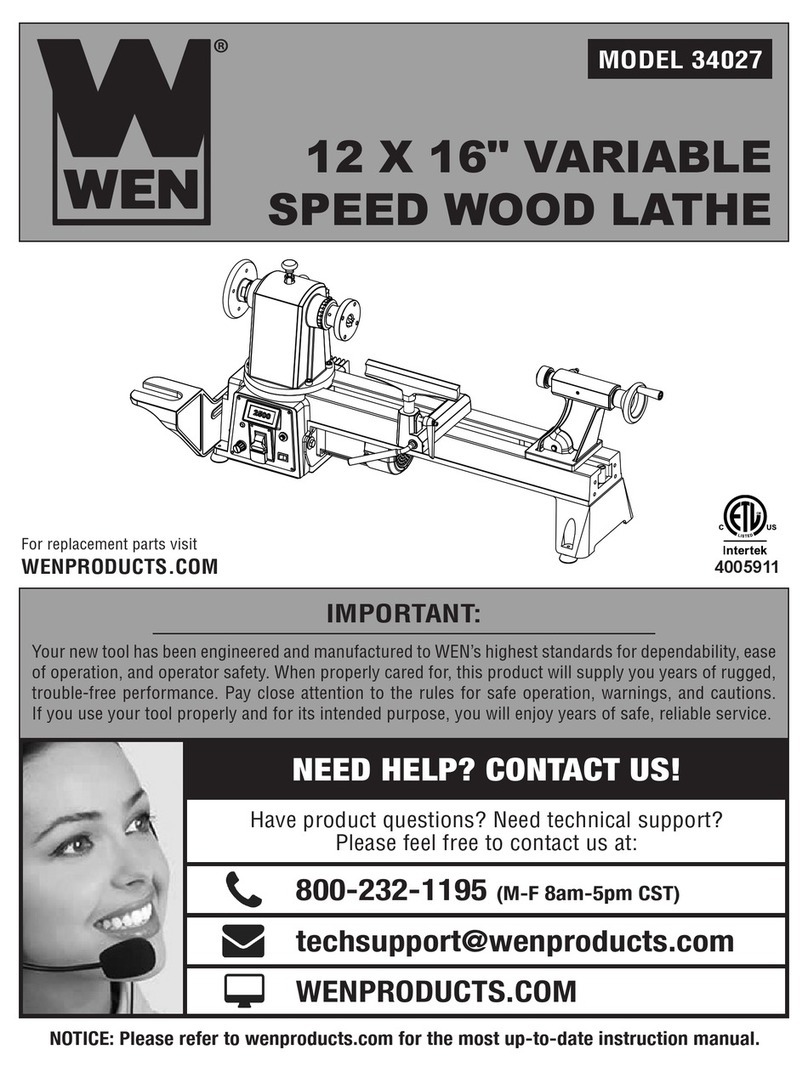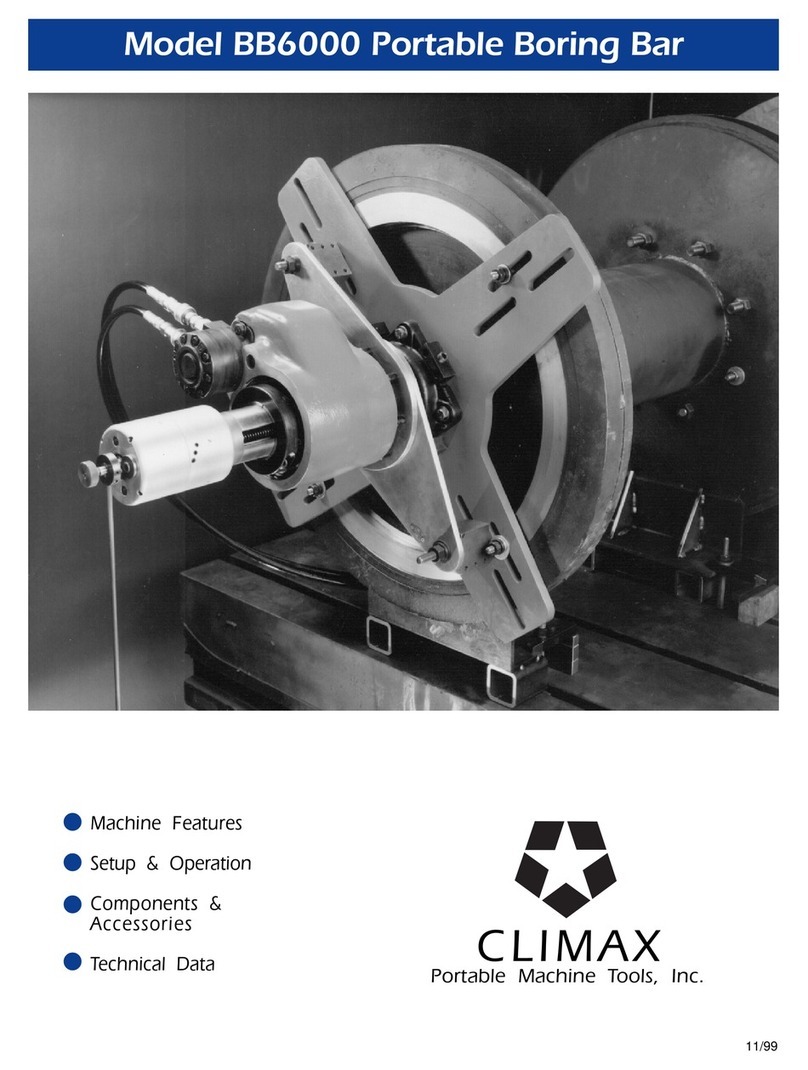Delta 46-700 User manual

DATED
8-1-91
PART
NO.
434-08-651-0001
©Delta
International
Machinery
Corp.
1991
I

TABLE
OF
CONTENTS
SAFETY
RULES.3
ADDITIONAL
SAFETY
RULES
FOR
WOOD
LATHES...
..4
UNPACKING
AND
CLEANING.....5
ASSEMBLING
AND
SETTING
UP
LATHE.5
CONNECTING
LATHE
TO
POWER
SOURCE
Power
Connections.
8
Grounding
Instructions
..........8
FASTENING
LATHE
TO
SUPPORTING
SURFACE..
..9
OPERATING
CONTROLS
AND
ADJUSTMENTS
Starting
And
Stopping
Lathe.....
9
Locking
Switch
in
The
“OFF”
Position
...
9
Spindle
Speeds.
1
0
Repositioning
Headstock
For
Outboard
turning.10
Tool
Rest........11
Tailstock.
1
1
Headstock
Spur
Center.......
12
Tailstock
Cup
Center........
12
OPERATION
Lathe
Tools.
1
3
How
To
Turn
Spindles
....13
Centering
The
Work..........14
Mounting
The
Work....
14
Tool
Rest
Position..
15
Roughing
A
Cylinder.........15
Position
of
Hands.
1
6
Smoothing
A
Cylinder.
1
6
Using
The
Parting
Tool.........16
Squaring
An
End...
1
7
Cutting
A
Shoulder.
1
7
Cutting
Small
Beads..
18
Vee
Grooves.........
18
Long
Cuts...........19
Cove
Cuts........
19
Square
Sections
..
2
0
Faceplate
Turning.
2
1
Mounting
Work
To
Faceplate.......
21
Inboard
Faceplate
Turning.
21
Outboard
Faceplate
Turning........22
Hollow
Tailstock...
2
3
MAINTENANCE
Replacing
Variable
Speed
Drive
Belt
....24
AUTHORIZED
SERVICE
STATIONS.
2
6
PARTS,
SERVICE
OR
WARRANTY
ASSISTANCE
....
.28
WARRANTY
..........28
2

SAFETY
RULES
As
with
all
machinery
there
are
certain
hazards
involved
with
operation
and
use
of
the
machine.
Using
the
machine
with
respect
and
caution
will
considerably
lessen
the
possibility
of
personal
injury.
However,
if
normal
safety
precautions
are
overlooked
or
ignored,
personal
injury
to
the
operator
may
result.
This
machine
was
designed
for
certain
applications
only.
Delta
Machinery
strongly
recommends
that
this
machine
NOT
be
modified
and/or
used
for
any
application
other
than
for
which
it
was
designed.
If
you
have
any
questions
relative
to
its
application
DO
NOT
use
the
machine
until
you
have
written
Delta
Machinery
and
we
have
advised
you.
DELTA
INTERNATIONAL
MACHINERY
CORP.
MANAGER
OF
TECHNICAL
SERVICES
246
ALPHA
DRIVE
PITTSBURGH,
PENNSYLVANIA
15238
{IN
CANADA:
644
IMPERIAL
ROAD,
GUELPH,
ONTARIO
N1H
6M7)
WARNING:
FAILURE
TO
FOLLOW
THESE
RULES
MAY
RESULT
IN
SERIOUS
PERSONAL
INJURY
1.
FOR
YOUR
OWN
SAFETY,
READ
INSTRUCTION
MANUAL
BEFORE
OPERATING
THE
TOOL.
Learn
the
tool’s
application
and
limitations
as
well
as
the
specific
hazards
peculiar
to
it.
2.
KEEP
GUARDS
IN
PLACE
and
in
working
order.
3.
ALWAYS
WEAR
EYE
PROTECTION.
4.
GROUND
ALL
TOOLS.
If
tool
is
equipped
with
three-
prong
plug,
it
should
be
plugged
into
a
three-hole
elec¬
trical
receptacle.
If
an
adapter
is
used
to
accommodate
a
two-prong
receptacle,
the
adapter
lug
must
be
attach¬
ed
to
a
known
ground.
Never
remove
the
third
prong.
5.
REMOVE
ADJUSTING
KEYS
AND
WRENCHES.
Form
habit
of
checking
to
see
that
keys
and
adjusting
wrenches
are
removed
from
tool
before
turning
it
“on.”
6.
KEEP
WORK
AREA
CLEAN.
Cluttered
areas
and
benches
invite
accidents.
7.
DON’T
USE
IN
DANGEROUS
ENVIRONMENT.
Don’t
use
power
tools
in
damp
or
wet
locations,
or
expose
them
to
rain,
Keep
work
area
well-lighted.
8.
KEEP
CHILDREN
AND
VISITORS
AWAY.
All
children
and
visitors
should
be
kept
a
safe
distance
from
work
area.
9.
MAKE
WORKSHOP
CHILDPROOF
-
with
padlocks,
master
switches,
or
by
removing
starter
keys.
10.
DON’T
FORCE
TOOL.
It
will
do
the
job
better
and
be
safer
at
the
rate
for
which
it
was
designed.
11.
USE
RIGHT
TOOL.
Don’t
force
tool
or
attachment
to
do
a
job
for
which
it
was
not
designed.
12.
WEAR
PROPER
APPAREL.
No
loose
clothing,
gloves,
neckties,
rings,
bracelets,
or
other
jewelry
to
get
caught
in
moving
parts.
Nonslip
foot
wear
is
recommend¬
ed.
Wear
protective
hair
covering
to
contain
long
hair.
13.
ALWAYS
USE
SAFETY
GLASSES.
Wear
safety
glasses
(must
comply
with
ANSI
Z87.1).
Everyday
eye¬
glasses
only
have
impact
resistant
lenses;
they
are
not
safety
glasses.
Also
use
face
or
dust
mask
if
cutting
opera¬
tion
is
dusty.
14.
SECURE
WORK.
Use
clamps
or
a
vise
to
hold
work
when
practical.
It’s
safer
than
using
your
hand
and
frees
both
hands
to
operate
tool.
15.
DON’T
OVERREACH.
Keep
proper
footing
and
balance
at
all
times,
16.
MAINTAIN
TOOLS
IN
TOP
CONDITION.
Keep
tools
sharp
and
clean
for
best
and
safest
performance.
Follow
instructions
for
lubricating
and
changing
accessories.
17.
DISCONNECT
TOOLS
before
servicing
and
when
changing
accessories
such
as
blades,
bits,
cutters,
etc.
18.
USE
RECOMMENDED
ACCESSORIES.
The
use
of
improper
accessories
may
cause
hazards.
19.
AVOID
ACCIDENTAL
STARTING.
Make
sure
switch
is
in
“OFF”
position
before
plugging
in
power
cord.
20.
NEVER
STAND
ON
TOOL.
Serious
injury
could
occur
if
the
tool
is
tipped
or
if
the
cutting
tool
is
accident¬
ally
contacted.
21.
CHECK
DAMAGED
PARTS.
Before
further
use
of
the
tool,
a
guard
or
other
part
that
is
damaged
should
be
carefully
checked
to
ensure
that
it
will
operate
properly
and
perform
its
intended
function
-
check
for
alignment
of
moving
parts,
binding
of
moving
parts,
breakage
of
parts,
mounting,
and
any
other
conditions
that
may
affect
its
operation.
A
guard
or
other
part
that
is
damaged
should
be
properly
repaired
or
replaced.
22.
DIRECTION
OF
FEED.
Feed
work
into
a
blade
or
cutter
against
the
direction
of
rotation
of
the
blade
or
cutter
only.
23.
NEVER
LEAVE
TOOL
RUNNING
UNATTENDED.
TURN
POWER
OFF.
Don’t
leave
tool
until
it
comes
to
a
complete
stop.
24.
DRUGS,
ALCOHOL,
MEDICATION.
Do
not
operate
tool
while
under
the
influence
of
drug,
alcohol
or
any
medication.
25.
MAKE
SURE
TOOL
IS
DISCONNECTED
FROM
POWER
SUPPLY
while
motor
is
being
mounted,
con¬
nected
or
reconnected.
26.
WARNING:
The
dust
generated
by
certain
woods
and
wood
products
can
be
injurious
to
your
health,
Always
operate
machinery
in
well
ventilated
areas
and
provide
for
proper
dust
removal.
Use
wood
dust
collection
systems
whenever
possible.
3

ADDITIONAL
SAFETY
RULES
FOR
WOOD
LATHES
1.
WARNING:
DO
NOT
operate
your
lathe
until
it
is
completely
assembled
and
installed
according
to
the
instructions.
2.
IF
YOU
ARE
NOT
thoroughly
familiar
with
the
opera¬
tion
of
wood
lathes,
obtain
advice
from
your
supervisor,
instructor
or
other
qualified
person.
3.
MAKE
SURE
wiring
codes
and
recommended
elec¬
trical
connections
are
followed
and
that
the
machine
is
properly
grounded.
4.
NEVER
turn
the
lathe
“ON”
before
clearing
the
lathe
bed
of
all
objects
(tools,
scraps
of
wood,
etc.).
5.
EXAMINE
set-up
carefully
before
turning
on
the
power.
6.
MAKE
SURE
tool
rest
height
is
adjusted
properly.
7.
MAKE
SURE
tool
rest
is
adjusted
as
close
to
the
workpiece
as
possible.
8.
ROTATE
workpiece
by
hand
to
check
clearance
before
engaging
power.
9.
NEVER
adjust
the
tool
rest
while
workpiece
is
turning.
10.
REMOVE
the
tool
rest
before
sanding
or
polishing.
11.
WHEN
TURNING
between
centers
MAKE
SURE
the
tailstock
center
is
snug
against
the
workpiece
and
locked.
The
tailstock
center
should
be
lubricated
if
it
is
not
a
ball
bearing
center.
12.
NEVER
drive
workpiece
into
drive
center
when
drive
center
is
in
headstock.
Set
drive
center
into
workpiece
with
a
soft
mallet
prior
to
installing
it
into
the
headstock.
13.
NEVER
loosen
tailstock
spindle
or
tailstock
while
workpiece
is
turning.
14.
WHEN
faceplate
turning,
MAKE
SURE
workpiece
is
securely
fastened
to
the
faceplate
and
that
appropriate
size
faceplate
is
used
to
properly
support
workpiece.
15.
WHEN
faceplate
turning,
MAKE
SURE
the
screw
fasteners
do
not
interfere
with
the
turning
tool
at
the
finished
dimension
of
the
workpiece.
16.
ROUGH
CUT
workpiece
as
close
as
possible
to
finished
shape
before
installing
on
faceplate.
17.
TIGHTEN
all
clamp
handles
before
operating.
18.
EXAMINE
workpiece
for
flaws
and
test
glue
joints
before
placing
workpiece
in
lathe.
19.
WHEN
roughing
off,
DO
NOT
jam
tool
into
work-
piece
or
take
too
big
a
cut.
20.
USE
lowest
speed
when
starting
a
new
workpiece.
21.
ALWAYS
operate
the
lathe
at
the
recommended
speeds.
Consult
owners
manual
for
suggested
speeds.
22.
MAKE
all
adjustments
with
the
power
“OFF.”
Change
speed
only
when
lathe
is
running.
23.
DISCONNECT
lathe
from
power
source
when
mak¬
ing
repairs.
24.
DISCONNECT
lathe
from
power
source
and
clean
the
machine
before
leaving
it.
25.
MAKE
SURE
the
work
area
is
cleaned
before
leaving
the
machine.
26.
SHOULD
any
part
of
your
lathe
be
missing,
dam¬
aged
or
fail
in
any
way,
or
any
electrical
component
fail
to
perform
properly,
shut
off
switch
and
remove
plug
from
the
power
supply
outlet.
Replace
missing,
damaged
or
failed
parts
before
resuming
operation.
27.
CAUTION:
To
reduce
the
risk
of
injury,
ALWAYS
wear
safety
glasses
and
face
and
head
protection
when
operating
wood
lathe.
28.
ADDITIONAL
INFORMATION
regarding
the
safe
and
proper
operation
of
this
product
is
available
from
the
National
Safety
Council,
444
N.
Michigan
Avenue,
Chicago,
IL
60611
in
the
Accident
Prevention
Manual
for
Industrial
Operations
and
also
in
the
Safety
Data
Sheets
provided
by
the
NSC.
Please
also
refer
to
the
American
National
Standards
institute
ANSI
01.1
Safety
Require¬
ments
for
Woodworking
Machines
and
the
U.S.
Depart¬
ment
of
Labor
OSHA
1910.213
Regulations.
4

UNPACKING
AND
CLEANING
Your
new
Wood
Lathe
is
shipped
complete
in
one
carton.
Carefully
unpack
the
wood
lathe
and
all
loose
items
from
the
carton.
Remove
the
protective
coating
from
the
lathe
bed
and
all
unpainted
parts.
This
coating
may
be
removed
with
a
soft
cloth
moistened
with
kerosene
(do
not
use
acetone,
gasoline,
or
lacquer
thinner
for
this
purpose).
After
cleaning
cover
the
lathe
bed
with
a
good
quality
paste
wax.
WARNING:
FOR
YOUR
OWN
SAFETY,
DO
NOT
CONNECT
THE
LATHE
TO
THE
POWER
SOURCE
UNTIL
THE
MACHINE
IS
COMPLETELY
ASSEMBLED
AND
YOU
HAVE
READ
AND
UNDERSTAND
THE
ENTIRE
OWNERS
MANUAL.
ASSEMBLING
AND
SETTING
UP
LATHE
E
F
H
Fig.
2
1.
Fig.
2,
illustrates
the
lathe
and
all
loose
items
after
they
are
removed
from
the
carton.
The
headstock
(A),
tool
rest
(B)
and
tailstock
(C)
are
mounted
to
the
lathe
bed
(D).
Loose
items
shipped
with
your
lathe
are
the
two
spindle
wrenches
(E),
headstock
positioning
wrench
(F),
headstock
spur
center
(G),
tailstock
cup
center
(H)
and
variable
speed
handle,
spring
and
screw
(J).
2.
Assemble
the
handle,
spring
and
screw
(J)
to
the
end
of
the
variable
speed
control
shaft,
as
shown
in
Fig.
3.
Fig.
3
5

3.
L
oosen
tailstock
locking
lever
(K)
Fig.
4,
and
remove
tailstock
(C)
from
left
end
of
lathe
bed.
4.
U
sing
the
headstock
positioning
wrench
(F)
Fig.
5,
loosen
screw
(L)
located
directly
underneath
headstock
(A)
just
enough
to
allow
the
headstock
(A)
to
slide
along
the
lathe
bed.
NOTE:
Do
not
overly
loosen
screw
(L).
5.
S
lide
headstock
(A)
Fig.
6,
to
the
left
end
of
lathe
bed
(D),
as
shown,
and
tighten
headstock
locking
screw
that
was
loosened
in
STEP
4.
Fig.
4
6.
U
sing
the
two
spindle
wrenches
(E)
Fig.
7,
remove
faceplate
(M)
from
headstock
spindle.
6
Fig.
7

7.
L
ift
up
tool
rest
base
locking
lever
(N)
Fig.
8,
and
loosen
tool
rest
locking
lever
(0).
8.
R
eposition
too!
rest
base
(P)
and
tool
rest
(Q)
on
lathe
bed
as
shown
in
Fig.
9,
and
tighten
locking
levers
(N)
and
(O).
9.
L
oosen
tailstock
locking
lever
(K)
Fig.
10,
and
slide
tailstock
(C)
onto
right
end
of
lathe
bed
as
shown.
NOTE:
Make
sure
clamp
(R)
is
in
position
underneath
lathe
bed.
10.
F
ig.
11,
illustrates
tailstock
(C)
mounted
on
right
end
of
lathe
bed.
Tighten
locking
lever
(K).

A
separate
electrical
circuit
should
be
used
for
your
tools.
This
circuit
should
not
be
less
than
#12
wire
and
should
be
protected
with
a
20
Amp
time
lag
fuse.
If
an
extension
cord
is
used,
use
only
3-wire
extension
cords
which
have
3-prong
grounding
type
plugs
and
3-pole
receptacles
which
accept
the
tools
plug.
For
distances
up
to
100
feet
use
#12
wire.
For
distances
up
to
150
feet
use
#10
wire.
Have
a
certified
electrician
replace
or
repair
damaged
or
worn
cord
immediately.
Before
connecting
the
motor
to
the
power
line,
make
sure
the
switch
is
in
the
“OFF”
position
and
be
sure
that
the
electric
current
is
of
the
same
characteristics
as
stamped
on
motor
nameplate.
All
line
connections
should
make
good
contact.
Running
on
low
voltage
will
injure
the
motor.
WARNING:
THIS
TOOL
MUST
BE
GROUNDED
WHILE
IN
USE
TO
PROTECT
THE
OPERATOR
FROM
ELECTRIC
SHOCK.
In
the
event
of
a
malfunction
or
breakdown,
grounding
provides
a
path
of
least
resistance
for
electric
current
to
reduce
the
risk
of
electric
shock.
This
tool
is
equipped
with
an
electric
cord
having
an
equipment-grounding
conductor
and
a
grounding
plug,
The
plug
must
be
plugged
into
a
matching
outlet
that
is
properly
installed
and
grounded
in
accordance
with
all
local
codes
and
ordinances.
Do
not
modify
the
plug
provided
-
if
it
will
not
fit
the
outlet,
have
the
proper
outlet
installed
by
a
qualified
electrician.
Improper
connection
of
the
equipment-grounding
conduc¬
tor
can
result
in
risk
of
electric
shock.
The
conductor
with
insulation
having
an
outer
surface
that
is
green
with
or
without
yellow
stripes
is
the
equipment-grounding
con¬
ductor.
If
repair
or
replacement
of
the
electric
cord
or
plug
is
necessary,
do
not
connect
the
equipment
grounding
conductor
to
a
live
terminal.
Check
with
a
qualified
electrician
or
service
personnel
if
the
grounding
instructions
are
not
completely
understood,
or
if
in
doubt
as
to
whether
the
tool
is
properly
grounded.
Use
only
3-wire
extension
cords
that
have
3-prong
ground¬
ing
type
plugs
and
3-hole
receptacles
that
accept
the
tool’s
plug,
as
shown
in
Fig.
12,
Repair
or
replace
damaged
or
worn
cord
immediately.
This
tool
is
intended
for
use
on
a
circuit
that
has
an
outlet
and
a
plug
that
looks
like
the
one
shown
in
Fig.
12.
A
temporary
adapter,
which
looks
like
the
adapter
illustrated
in
Fig.
13,
may
be
used
to
connect
this
plug
to
a
2-pole
receptacle,
as
shown
in
Fig.
13,
if
a
properly
grounded
outlet
is
not
available.
The
temporary
adapter
should
be
used
only
until
a
properly
grounded
outlet
can
be
installed
by
a
qualified
electrician.
THIS
ADAPTER
IS
NOT
APPLICABLE
IN
CANADA.
The
green-colored
rigid
ear,
lug,
and
the
like,
extending
from
the
adapter
must
be
connected
to
a
permanent
ground,
such
as
a
properly
grounded
outlet
box,
as
shown
in
Fig.
13.
CAUTION:
IN
ALL
CASES,
MAKE
CERTAIN
THE
RE¬
CEPTACLE
IN
QUESTION
IS
PROPERLY
GROUNDED.
IF
YOU
ARE
NOT
SURE
HAVE
A
CERTIFIED
ELEC¬
TRICIAN
CHECK
THE
RECEPTACLE.
8

FASTENING
LATHE
TO
SUPPORTING
SURFAC
Fig.
14
This
machine
must
be
fastened
to
a
supporting
surface.
Four
holes,
two
of
which
are
shown
at
(A)
Fig.
14,
are
provided
in
the
lathe
bed
for
this
purpose.
IMPORTANT:
If
the
lathe
is
to
be
mounted
to
the
accessory
46-705
stand,
the
stand
must
be
fastened
to
a
supporting
surface
if
it
has
any
tendency
to
tip
over,
slide
or
“walk”
during
operation.
OPERATING
CONTROLS
AND
ADJUSTMENTS
STARTING
AND
STOPPING
LATHE
The
switch
(A)
Fig.
15,
is
located
on
the
end
of
the
motor.
To
turn
the
lathe
“ON”
move
the
switch
to
the
up
posi¬
tion.
To
turn
the
lathe
“OFF”
move
the
switch
to
the
down
position.
LOCKING
SWITCH
IN
THE
“OFF”
POSITION
IMPORTANT:
We
suggest
that
when
the
lathe
is
not
in
use
the
switch
be
locked
in
the
“OFF”
position
using
a
padlock
(B)
Fig,
16,
through
the
holes
in
the
switch
bracket,
as
shown.
Fig.
15
9
Fig.
16

SPINDLE
SPEEDS
Your
12"
Wood
Lathe
is
provided
with
variable
rate
spindle
speeds
from
500
to
2000
RPM.
IMPORTANT:
CHANGE
SPEEDS
ONLY
WHEN
LATHE
IS
RUNNING.
To
change
speeds,
rotate
speed
control
lever
(A)
Fig.
17.
Turning
the
lever
(A)
clockwise
increases
the
speed
and
turning
it
counterclockwise
decreases
the
speed.
NOTE:
Lever
(A)
is
spring-loaded
and
can
be
repositioned
by
pulling
out
on
the
lever
and
repositioning
it
on
the
nut
located
underneath
the
lever.
Fig.
17
Refer
to
Fig.
18,
for
the
recommended
spindle
speeds
when
wood-turning
on
your
machine.
RECOMMENDED
SPINDLE
SPEEDS
DIAMETER
OF
WORK
ROUGHING
OFF
GENERAL
CUTTING
FINISHING
Under
2"
Dia.
2"
to
4"
Dia.
4"
to
6"
Dia.
6"
to
8"
Dia.
8"
to
12"
Dia.
900
to
1300
RPM
600
to
1000
RPM
600
to
800
RPM
500
to
600
RPM
500
RPM
1200
to
2000
RPM
1000
to
2000
RPM
1000
to
1800
RPM
800
to
1200
RPM
600
to
800
RPM
1500
to
2000
RPM
1500
to
2000
RPM
1500
to
2000
RPM
1200
to
1800
RPM
900
to
1200
RPM
Fig.
18
REPOSITIONING
HEADSTOCK
FOR
OUTBOARD
TURNING
1.
To
reposition
headstock
(A)
Fig.
19,
for
outboard
faceplate
turning,
loosen
locking
screw
located
directly
underneath
headstock
with
wrench
(B)
supplied,
just
enough
to
allow
you
to
slide
headstock
(A)
to
the
center
of
the
lathe
bed.
2.
With
headstock
(A)
Fig.
19,
in
position
at
the
center
of
the
lathe
bed,
loosen
the
headstock
locking
screw
again,
just
enough
to
allow
you
to
rotate
headstock
(A)
90
degrees
to
the
right
until
spindle
(C)
is
facing
out.
Then
tighten
screw
underneath
headstock
(A)
with
wrench
(B).
Fig.
19
10

TOOL
REST
The
tool
rest
(A)
and
tool
rest
base
(B)
is
shown
in
Fig.
20.
To
position
the
tool
rest
on
the
lathe
bed,
lift
up
clamp
handle
(C),
move
the
tool
rest
base
to
the
desired
posi¬
tion
and
lock
in
place
by
pushing
down
on
handle
(C).
To
adjust
the
tool
rest
(A)
for
the
correct
height,
loosen
locking
lever
(D),
move
tool
rest
(A)
up
or
down
and
tighten
locking
lever
(D).
NOTE:
Locking
lever
(D)
can
be
repositioned
by
removing
nut
(E)
and
lever
(D).
Reposition
lever
(D)
on
the
nut
located
underneath
the
lever
(D)
and
replace
nut
(E).
Clamping
action
of
clamp
handle
(C)
Fig.
21,
can
be
adjusted
by
removing
the
tool
rest
base
from
the
lathe
bed
and
tightening
or
loosening
nut
(F).
Fig.
21
TAILSTOCK
The
tailstock
(A)
Fig.
22,
can
be
moved
lengthwise
along
the
lathe
bed
by
loosening
locking
lever
(B),
sliding
tail-
stock
(A)
to
the
desired
position
on
the
bed,
and
tighten¬
ing
lever
(B).
The
tailstock
spindle
(C)
Fig.
22,
moves
in
or
out
of
the
tailstock
body
by
loosening
locking
lever
(D)
and
turning
handwheel
(E).
Total
movement
of
the
tailstock
spindle
(C)
is
two
inches.
The
tailstock
spindle
is
hollow
the
com¬
plete
length
of
the
tailstock
enabling
you
to
bore
holes
through
turnings
as
shown
later
in
this
manual.
NOTE:
Locking
lever
(B)
is
spring-loaded
and
can
be
repositioned
by
pulling
out
on
the
handle
and
repositioning
it
on
the
nut
located
underneath
the
lever.
Locking
lever
(D)
Fig.
23,
can
be
repositioned
by
removing
nut
(F)
and
lever
(D).
Reposition
lever
(D)
on
the
nut
located
underneath
lever
(D)
and
replace
nut
(F).
Fig.
23
11

HEADSTOCK
SPUR
CENTER
The
spur
center
(A)
Fig.
24,
supplied
with
your
lathe,
is
equipped
with
a
No.
2
Morse
Taper
shank
and
is
inserted
into
the
headstock
spindlfe
(B)
as
shown.
To
remove
the
tapered
shank
spur
center
(A)
from
the
headstock
spindle,
use
a
dowel
rod
or
a
piece
of
soft
metal
rod
through
the
hole
(C)
Fig.
25,
in
the
opposite
end
of
the
spindle.
Available
as
an
accessory
for
your
lathe
is
the
Cat.
No.
46-905
Knockout
Bar
which
is
ideal
for
this
purpose.
It
is
equipped
with
a
brass
plug
on
one
end
and
a
comfortable
knob
on
the
other.
IMPORTANT:
NEVER
DRIVE
THE
WORKPIECE
INTO
THE
SPUR
CENTER
WHEN
IT
IS
MOUNTED
IN
THE
HEADSTOCK.
Instructions
on
setting
the
spur
center
into
the
workpiece
are
found
in
the
OPERATION
section
of
this
manual.
TAILSTOCK
CUP
CENTER
The
tailstock
cup
center
(A)
Fig,
26,
supplied
with
your
lathe,
is
equipped
with
a
No.
2
Morse
Taper
shank
and
is
inserted
into
the
tailstock
spindle
(B),
as
shown.
To
remove
the
tapered
shank
cup
center
(A)
from
the
tailstock
spindle,
simply
rotate
handwheel
(C)
to
move
spindle
(B)
back
into
the
tailstock
body.
This
will
push
the
cup
center
(A)
out
of
the
spindle
(B).
I
B
Fig.
26
Fig.
25
12

The
following
directions
will
give
the
inexperienced
operator
a
start
on
the
common
lathe
operations.
Use
scrap
materia!
for
practice
to
get
the
feel
of
the
machine
before
attempting
regular
work.
The
standard
set
of
tools
used
in
wood
turning
comprises
five
different
shapes
as
shown
in
Fig.
27.
Most
important
of
these
is
the
gouge,
a
roundnose,
hollow
chisel
which
is
used
for
roughing
cuts,
cove
cutting
and
other
opera¬
tions.
Next
in
importance
is
the
skew
chisel,
a
double¬
ground,
flat
chisel,
with
the
end
ground
to
an
angle
instead
of
being
square
across.
This
tool
is
used
for
smoothing
cylinders,
for
cutting
shoulders,
beads,
vee-
grooves,
etc.
The
spear
or
diamond-point
chisel
and
the
round-nose
chisel
are
scraping
tools
which
are
used
where
their
shape
fits
the
contour
of
the
work.
The
parting
tool
is
a
double-ground
chisel,
and
is
used
for
cutting-off
and
for
making
straight
incisions
or
sizing
cuts
to
any
required
diameter.
Any
turning
where
the
workpiece
is
placed
between
the
headstock
and
tailstock
centers,
as
shown
in
Fig.
28,
is
called
spindle
turning.
This
is
the
principle
type
of
wood
turning,
as
typified
by
chair
and
table
legs,
lamp
stems,
etc.
The
turning
of
spindles
can
be
done
with
either
a
scraping
or
cutting
technique,
the
cutting
technique
by
virtue
of
faster
wood
removal
and
a
cleaner
surface
being
almost
a
must
for
good
work.
Fig.
29,
illustrates
a
spindle
turning
operation
being
performed.
Fig.
28
Fig.
29

Wood
stock
for
any
spindle
turning
should
be
approxi¬
mately
square,
and
the
ends
should
be
square
with
the
sides.
Two
common
methods
of
determining
the
center
are
shown
in
Fig.
30
and
31.
In
Fig.
30
a
distance
a
little
more
or
a
little
less
than
one-half
the
width
of
the
stock
is
set
off
from
each
of
the
four
sides,
The
small
square
thus
set
off
in
the
center
can
then
be
used
in
marking
the
true
center.
The
diagonal
method,
Fig.
31,
consists
of
drawing
lines
from
corner
to
corner,
the
intersection
marking
the
center
of
the
work.
After
marking
each
end,
the
true
center
should
be
defi¬
nitely
marked
with
a
punch
awl
or
dividers,
as
shown
in
Fig,
32.
If
the
stock
is
hardwood,
the
centers
should
be
drilled
to
a
depth
of
about
1/8”,
as
shown
in
Fig.
33.
The
spur
or
live
center
is
then
placed
against
one
end
of
the
work
and
seated
by
striking
with
a
mallet,
as
shown
in
Fig.
34,
In
hardwood,
it
is
advisable
to
make
a
starting
seat
for
the
spur
center,
this
being
done
by
sawing
on
the
diagonal
lines,
as
shown
in
Fig.
35,
and
drilling
a
small
hole
at
the
intersection.
After
driving
the
center,
it
is
best
to
hold
center
and
work
together
and
fit
immediately
to
headstock
spindle.
If
you
are
not
using
a
ball
bearing
center,
the
end
of
work
at
tailstock
center
should
be
oiled,
placing
the
lubricant
on
the
wood
either
before
or
after
it
is
put
in
the
lathe,
see
Fig,
36.
Many
turners
use
bees¬
wax,
tallow,
or
a
wax-and-oil
mixture
as
a
lubricant,
The
ideal
method
is
to
use
a
ball
bearing
center,
which
elimi¬
nates
lubricating
entirely.
If
the
work
is
to
be
removed
from
the
lathe
before
completion,
an
index
mark
should
be
made
as
a
guide
for
recentering,
as
shown
in
Fig.
37.
A
permanent
indexer
can
be
made
by
grinding
off
one
corner
of
one
of
the
spurs.
Fig.
32
Fig.
33
Fig.
36
Fig.
37
MOUNTING
THE
WORK
Mounting
the
work
is
done
by
moving
the
tailstock
up
to
a
position
about
1
or
IV
2
”
from
the
end
of
the
stock,
and
locking
it
in
this
position.
Advance
the
tailstock
center
by
turning
the
feed
handle
until
the
center
makes
contact
with
the
work.
Continue
to
advance
the
center
while
slowly
rotating
the
work
by
hand.
After
it
becomes
difficult
to
turn
the
work,
slack
off
on
the
feed
about
one-quarter
turn
and
lock
the
tailstock
spindle.
14

TOOL
REST
POSITION
The
tool
rest
is
now
mounted,
in
place,
about
1/8”
away
from
the
work
and
1/8”
above
the
work
centerline,
as
shown
in
Fig.
38.
This
position
may
be
varied
to
suit
the
work
and
the
operator.
A
guide
mark
to
show
the
most
suitable
working
position
can
be
placed
on
the
tool
rest
shank
as
an
aid
to
quick
and
accurate
re-setting.
Once
some
experience
has
been
obtained,
the
setting
of
the
tool
rest
will
become
almost
second-nature.
ROUGHING
A
CYLINDER
The
large
gouge
is
used
in
the
first
turning
operation
of
roughing-off
the
sharp
corners
of
the
work.
Run
the
lathe
at
low
speed
and
hold
the
gouge
in
the
manner
shown
in
Fig.
39.
The
cut
starts
about
2
inches
from
the
tailstock
end,
and
continues
from
this
point
towards
and
off
the
tailstock
end.
A
second
bite
is
then
taken
about
2
or
3”
to
the
left
of
the
first
cut,
advancing
again
towards
the
tailstock
to
merge
with
the
cut
previously
made.
The
pro¬
cedure
continues
until
a
point
about
2”
from
the
live
center
is
reached
where
the
gouge
is
rolled
in
the
opposite
direc¬
tion
to
carry
the
final
cut
off
the
live
center
end
of
the
work.
The
roughing
cut
should
not
be
carried
out
with
one
con¬
tinuous
movement
as
this
tends
to
tear
long
slivers
from
the
corners
of
the
work;
neither
should
the
cut
be
started
directly
at
the
end
of
the
stock
for
the
same
reason.
The
cut
can
be
safely
carried
from
the
center
of
the
stock
towards
and
off
either
end
once
the
first
roughing
cut
has
been
made.
The
position
of
the
gouge
in
relation
to
the
work
involves
two
or
three
important
angles.
First
of
all,
the
tool
may
be
advanced
along
the
work
either
from
right
to
left
or
from
left
to
right.
From
left
to
right
or
from
headstock
towards
tailstock
is
preferable,
since
this
throws
the
chips
clear
of
the
operator.
The
gouge
is
rolled
over
slightly
in
the
same
direction
it
is
advancing,
as
shown
in
Fig.
40.
The
tool
is
held
well
up
on
the
work,
with
the
bevel
or
grind
tangent
to
the
revolving
surface,
as
shown
in
Fig.
41.
In
this
position
it
will
make
a
clean,
shearing
cut.
When
pushed
straight
into
the
work,
like
Fig.
42,
the
gouge
has
a
scraping
action,
which
is
normally
poor
practice
in
spindle
turning.
The
roughing
cut
is
continued
until
the
work
approaches
1/8”
of
the
required
diameter,
stepping
up
to
second
or
third
speed
once
a
barely
cylindrical
form
has
been
obtained.
Fig.
39
15

In
all
tool
handling,
the
handle
hand
takes
a
natural
posi¬
tion,
being
nearer
or
further
from
the
end
of
chisel
depend¬
ing
on
the
amount
of
leverage
required.
The
position
of
the
tool
rest
hand
is
more
a
matter
of
individual
liking
rather
than
any
set
or
“proper”
position.
However,
a
palm-
up
grip,
as
illustrated
with
the
gouge,
is
generally
con¬
sidered
the
best
practice.
In
this
position,
the
first
finger
acts
as
a
guide,
as
shown
in
Fig.
43,
sliding
along
the
too!
rest
as
the
cut
is
made.
The
alternate
position
is
a
palm-
down
grip,
which
is
shown
in
Fig.
44.
In
this
position,
the
heel
of
the
hand
or
the
little
finger
serves
as
a
guide.
The
palm-down
position
is
solid
and
positive-excellent
for
roughing
or
heavy
cutting.
Most
beginners
start
with
the
palm-down
grip,
switching
later
to
the
palm-up
position
for
better
manipulation
of
the
chisel.
This
operation
is
done
with
the
large
skew
chisel.
It
demands
a
little
practice,
but
should
be
mastered
thoroughly
because
it
is
one
of
the
most
important
cuts
in
turning.
Fig.
43
and
44
show
how
the
chisel
is
held,
using
either
grip
as
desired.
The
cutting
point
is
near
the
center
of
chisel
and
high
on
the
work,
as
shown
in
Fig.
45.
The
chisel
must
be
supported
by
the
tool
rest
at
all
times
-
in
striving
for
a
certain
position
in
relation
to
the
work,
the
beginner
often
overlooks
this
all-important
point.
Beginners
often
use
the
method
shown
in
Fig.
45
to
locate
the
proper
tool
position.
To
do
this,
you
place
the
skew
well
over
the
work
and
riding-flat
against
it.
Pulling
back
slowly
on
the
tool
will
eventually
put
it
into
position
where
it
will
bite
into
the
wood.
Raising
the
handle
increases
the
depth
of
cut;
lowering
the
handle
makes
the
cut
less.
As
with
the
gouge,
the
skew
can
be
advanced
in
either
direction.
The
part
of
the
skew
which
does
the
actual
cutting
is
the
center
portion
and
toward
the
heel.
It
is
worthwhile
to
stop
a
test
cut
in
progress
and
note
just
how
the
skew
cuts.
You
will
note
that
the
back
portion
of
the
grind
or
bevel
supports
the
tool,
and
the
handle
hand
controls
the
depth
of
cut
by
rocking
the
chisel
on
this
pivot
point.
For
this
reason
it
is
important
that
the
skew
bevel
be
kept
perfectly
flat,
not
a
double
bevel
nor
rounded.
The
parting
tool
is
perhaps
the
easiest
turning
chisel
to
handle.
It
is
a
scraping
tool,
and
is
simply
pushed
into
the
work,
as
shown
in
Figs.
46,
47
and
48.
A
somewhat
bet¬
ter
cutting
action
is
obtained
if
the
handle
is
held
low,
raising
gradually
as
the
work
diameter
decreases,
as
shown
in
Fig.
46.
The
tool
is
frequently
used
with
one
hand,
the
other
hand
holding
calipers
in
the
groove
being
cut.
When
parting
tool
cuts
are
deep,
a
clearance
cut
should
be
made
alongside
the
first
cut,
as
shown
in
Fig.
47,
to
prevent
burning
the
tool
point.
Fig.
43
Fig.
44
Fig.
48
16

SQUARING
AN
END
This
operation
can
be
done
with
parting
tool.
However,
the
parting
tool
is
a
rough
cutter,
so
that
ultimately
the
skew
must
be
used
in
cleaning
the
cut.
The
whole
opera¬
tion
can
be
done
with
the
skew,
and
this
technique
is
illustrated
by
the
drawings
in
Figs.
49,
50
and
51.
The
first
movement
is
a
nicking
cut
with
the
toe
of
the
skew,
as
shown
in
Fig.
49.
This
cut
cannot
be
made
very
deep
without
danger
of
burning
the
chisel,
so
a
clearance
cut
is
made
by
inclining
the
skew
away
from
the
first
cut
and
again
pushing
the
tool
into
the
work.
This
procedure
of
side
cut
and
clearance
cut
is
continued
as
often
as
needed.
The
important
point
to
note
is
that
while
the
skew
can
be
pushed
into
the
wood
in
any
direction,
the
cutting
edge
itself
must
be
inclined
a
little
away
from
this
plane,
see
Fig.
51.
Note
that
if
the
full
cutting
edge
of
skew
bears
against
the
cut
surface,
the
tool
will
have
a
tendency
to
run.
Now,
observe
the
proper
way
to
make
the
cut,
as
shown
at
left
end
of
Fig.
51.
The
chisel
is
pushed
straight
into
the
work,
but
the
cutting
edge
is
inclined
away
from
the
cut
surface
-
only
the
extreme
toe
cuts.
This
is
the
most
important
principle
in
skew
handling,
and
you
will
run
into
it
repeatedly
in
making
shoulders,
beads
and
vee
cuts.
CUTTING
A
SHOULDER
The
parting
tool
is
first
used
to
reduce
the
wood
to
within
1/16”
of
the
required
shoulder
and
diameter,
as
shown
in
Fig.
52.
The
waste
stock
is
then
cleaned
out
with
the
gouge,
Fig.
53.
Actual
cutting
of
the
shoulder
is
done
with
the
skew,
as
shown
in
Fig.
54,
and
is
a
duplication
of
squaring
end.
The
horizontal
cut
is
also
made
with
the
skew,
but
in
a
little
different
manner
from
that
used
in
doing
plain
cylinder
work.
If
the
shoulder
is
long,
the
ordinary
skew
position
can
be
used
for
the
outer
portion
of
the
cut,
but
at
the
angle
between
the
horizontal
and
vertical
cuts,
the
heel
of
the
chisel
moves
into
a
position
tangent
between
the
skew
and
the
cylinder,
as
shown
in
Fig.
55.
In
this
position,
the
handle
of
the
chisel
is
raised
slightly
to
allow
it
to
cut
as
the
tool
moves
along
the
rest.
A
very
light
cut
should
be
taken
in
order
to
produce
smooth
work.
The
heel
of
the
skew
can
be
used
for
making
the
entire
cut,
if
desired,
but
the
cut,
whether
in
this
posi¬
tion
or
any
other
position,
should
not
be
picked
up
directly
at
the
end
of
the
stock.
It
is
quite
evident
that
any
hori¬
zontal
cut
started
directly
from
the
end
of
the
work
will
have
a
tendency
to
bite
into
the
wood,
often
ruining
the
entire
piece.
Always
run
off
the
end
and
not
into
it.
Where
a
very
short
shoulder
makes
this
impossible,
it
is
best
to
use
the
skew
flat
in
a
scraping
position.
If
the
cutting
technique
is
used,
engage
only
with
the
heel
of
skew
in
a
very
light
cut.
Fig.
49
Fig.
50
Fig.
51
Fig.
53
Fig.
54
17
Fig.
55

CUTTING
SMALL
BEADS
Beads
can
be
scraped
or
cut.
The
easy
method
of
scrap¬
ing
is
done
with
the
spear
chisel,
and
works
to
best
advantage
on
beads
separated
by
parting
tool
cuts,
as
shown
in
Fig.
56.
Scraping
is
slower
and
less
productive
of
clean
work
than
cutting,
but
it
has
the
advantage
of
perfect
safety
-
you
won’t
spoil
the
work
with
long
gash
runs.
Cutting
beads
quickly
and
accurately
with
the
small
skew
is
one
of
the
most
difficult
lathe
operations.
Various
work¬
ing
methods
can
be
used,
the
usual
system
being
as
shown
in
Figs.
57,
58
and
59.
The
first
cut
is
a
vertical
incision
at
the
point
where
the
two
curved
surfaces
will
eventually
come
together.
This
cut
can
be
made
with
either
heel
or
toe
of
skew,
Fig.
60
showing
the
toe
being
used.
Now,
place
the
skew
at
right
angles
to
the
work
and
well
up
on
the
cylinder,
as
shown
in
Fig.
57.
The
chisel
is
flat
on
its
side
at
the
start,
and
is
evenly
rotated
through
the
successive
stages
of
the
cut,
as
shown
in
Figs.
57,
58
and
59.
At
the
same
time,
the
chisel
is
pulled
slightly
backwards
to
maintain
the
cutting
point.
The
entire
cut
is
made
with
the
heel
of
chisel.
The
opposite
side
of
the
bead
is
cut
in
the
same
manner,
one
cut
serving
to
pro¬
duce
the
full
shape
in
each
instance.
Beads
cut
in
this
manner
are
beautifully
smooth
and
polished,
and
the
technique
is
well
worth
mastering.
1
.
1
a
Bn
Fig.
59
VEE
GROOVES
Cutting
the
vee
groove
demands
much
the
same
techni¬
que
as
the
bead,
except
the
skew
is
hinged
straight
into
the
work
without
rotation,
as
shown
in
Fig.
61.
Only
one-
haif
of
the
vee
is
made
at
a
time,
and
one,
two
or
more
cuts
may
be
needed
on
each
side
to
obtain
the
desired
shape.
As
in
all
cutting
with
the
skew,
the
bevel
next
to
the
cut
must
be
used
as
a
fulcrum,
without
at
the
same
time
allowing
the
full
edge
of
the
chisel
to
catch
and
cause
a
run.
Vee
grooves
can
also
be
made
with
the
toe
of
the
skew,
in
the
manner
already
described
for
squaring
an
end.
Fig.
61
18

LONG
CUTS
Long
cuts
are
usually
either
convex
or
straight-tapered
surfaces.
With
a
convex
surface,
the
method
used
in
making
the
finishing
cut
is
shown
in
Fig.
62
and
63.
The
gouge
is
turned
on
the
tool
rest
so
that
it
will
be
inclined
considerably
in
the
direction
in
which
it
is
about
to
move.
The
grind
is
tangent
to
the
work,
and
the
center
point
of
the
cutting
edge
is
the
contact
point
with
the
wood.
As
the
cut
progresses
towards
and
around
the
end
of
the
curve,
the
handle
is
gradually
raised
and
swung
to
the
right,
as
shown
in
Fig.
63,
in
order
to
maintain
the
tan-
gency
between
the
grind
and
the
surface
being
cut,
as
shown
in
Fig.
64.
Figs.
65
and
66
show
the
cutting
of
a
long
taper.
The
skew
is
used,
and
the
operation
differs
from
smoothing
a
cylinder
only
as
regards
the
start
of
the
cut.
The
starting
cut
should
be
made
with
the
heel,
as
shown
in
Fig.
66,
to
prevent
the
tool
from
digging
into
the
work.
As
the
tool
runs
down
the
work,
the
chisel
can
be
pulled
back
to
allow
the
center
point
of
the
cutting
edge
to
cut.
However,
the
full
taper
can
be
made
with
the
heel.
There
will
be
a
tendency
to
cut
too
deeply
at
the
center
of
the
taper
which
should
be
guarded
against.
The
direction
of
cutting
is
always
downhill.
Fig.
64
Fig.
65
COVE
CUTS
Second
to
forming
a
perfect
bead,
the
cove
or
concave
cut
is
the
most
difficult
to
master.
This
cut
is
made
with
the
gouge,
the
size
of
the
tool
depending
upon
the
size
of
the
cut.
The
size
of
the
intended
cove
is
first
laid
out,
and
the
gouge
is
pushed
directly
into
the
work
to
remove
the
surplus
stock,
as
pictured
in
Fig.
67.
The
cove
cut
can
now
be
made.
19

The
gouge
is
placed
on
edge
on
the
tool
rest
in
such
a
position
that
the
grind
of
the
chisel
forms
an
approximate
right
angle
with
the
work,
as
shown
in
Figs.
68
and
69.
The
chisel
contacts
the
work
at
the
center
of
the
cutting
edge,
the
tool
being
held
so
that
the
centerline
of
the
gouge
is
pointing
directly
towards
the
center
of
the
revolv¬
ing
stock,
as
shown
in
Fig.
70.
This
starting
position
is
important;
otherwise
the
gouge
will
have
a
tendency
to
run
along
the
surface
of
the
work.
From
the
starting
position,
the
gouge
is
pushed
into
the
revolving
stock,
and
the
tool
is
rolled
on
the
rest.
A
triple
action
takes
place
here:
First,
the
chisel
is
rolled
to
follow
the
shape
of
the
cut;
second,
the
handle
is
dropped
slightly
so
that
the
portion
already
cut
will
force
the
lip
of
the
chisel
sidewise;
third,
the
chisel
is
pushed
forward
so
that
at
the
end
of
the
cut,
Fig.
71,
it
will
be
well
up
on
the
work
and
tangent
with
the
cut
surface.
Only
one-half
of
the
cut
is
made
at
one
time,
then
the
chisel
is
reversed
to
cut
the
other
half.
The
occasional
turner
is
advised
to
make
cove
cuts
with
a
scraping
technique,
using
either
the
small
gouge
or
round
nose
chisel.
SQUARE
SECTIONS
When
the
turning
has
a
square
section,
the
stock
should
be
jointed
before
turning.
Good
centering
is
essential
since
any
error
will
show
at
the
shoulder
where
the
round
meets
the
square.
Turning
of
the
shoulder
from
square
to
round
can
be
done
in
various
ways,
one
method
being
pictured
in
Figs.
72,
73,
74
and
75.
If
the
parting
tool
is
sharp,
the
nicking
cut
with
skew,
Fig.
72,
can
be
omitted.
The
final
trimming
operation
Fig.
75,
can
be
done
with
either
the
skew
or
spear
chisels.
This
is
a
scraping
opera¬
tion.
While
the
shoulder
can
be
cut
with
the
same
techni¬
que
used
for
cutting
a
bead,
the
simpler
scraping
method
pictured
does
clean
work
and
is
easier
to
do.
Fig.
70
Fig.
74
20
Fig.
75
Table of contents
Other Delta Lathe manuals
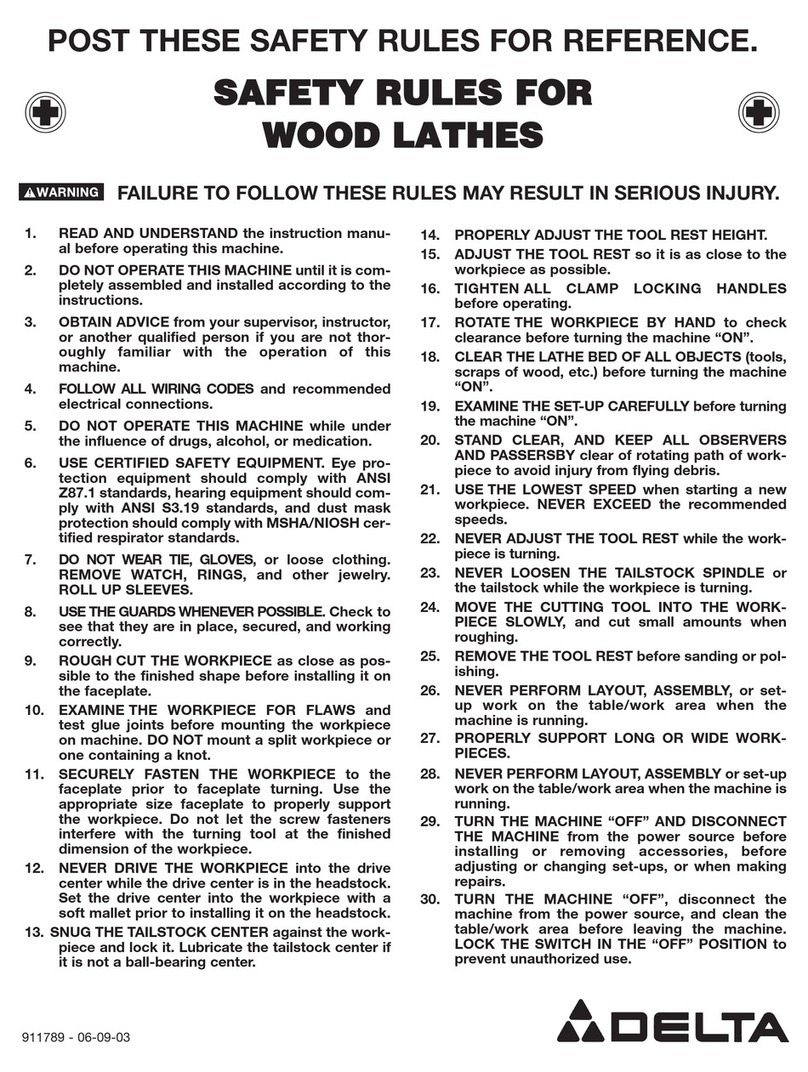
Delta
Delta Wood Lathe User manual
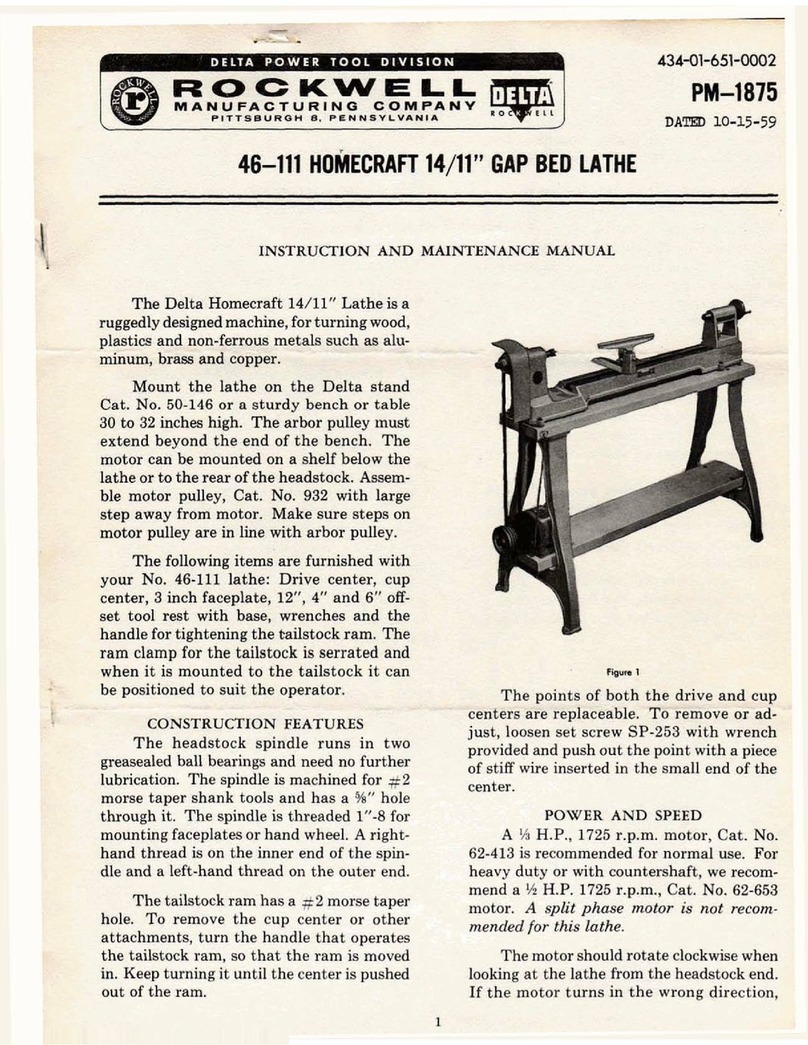
Delta
Delta PM-1875 Instructions for use
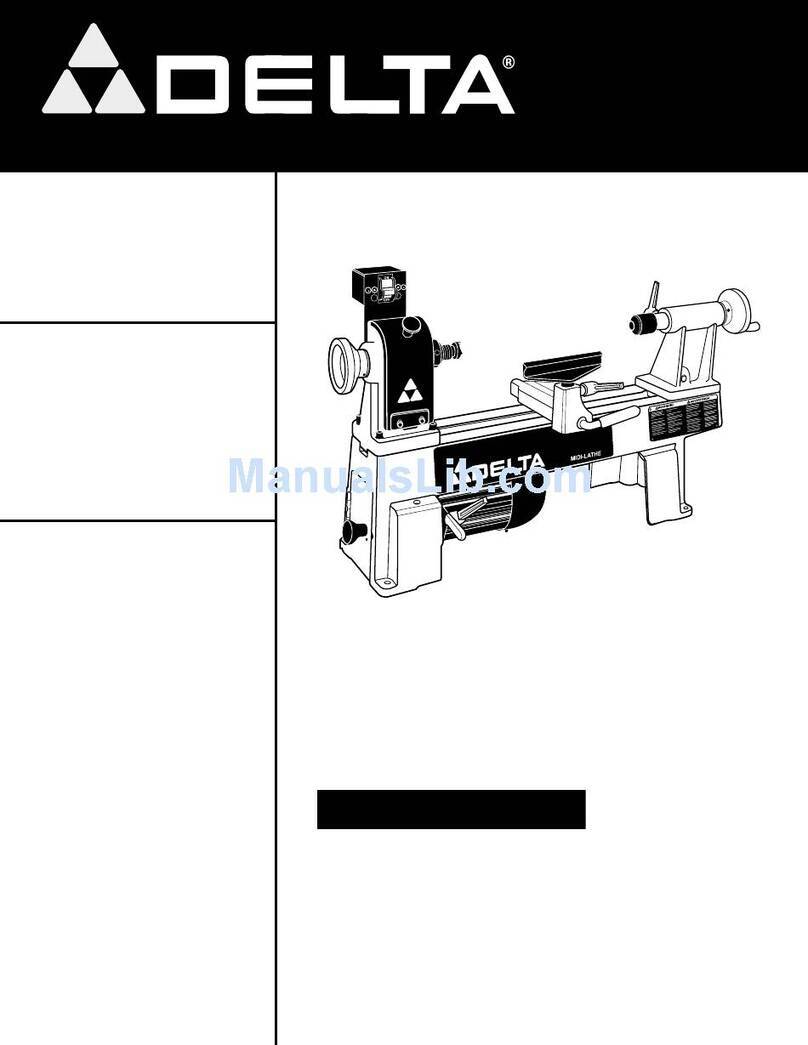
Delta
Delta LA200 User manual
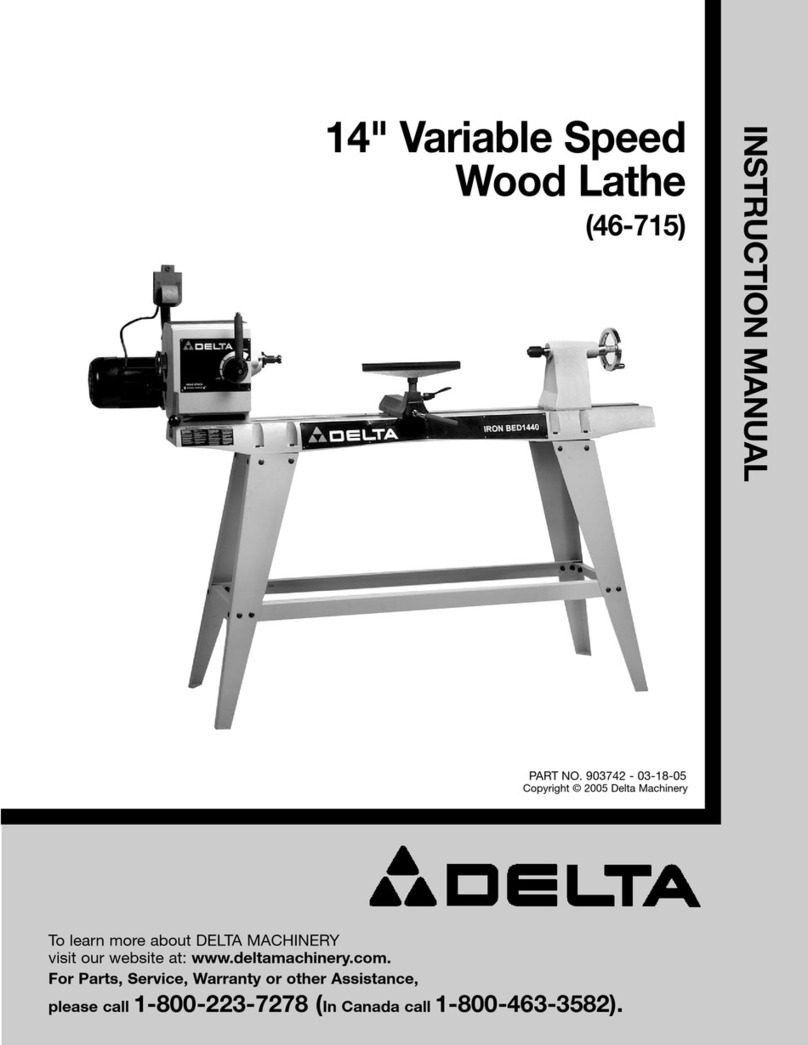
Delta
Delta 46-715 User manual

Delta
Delta 46-745 User manual
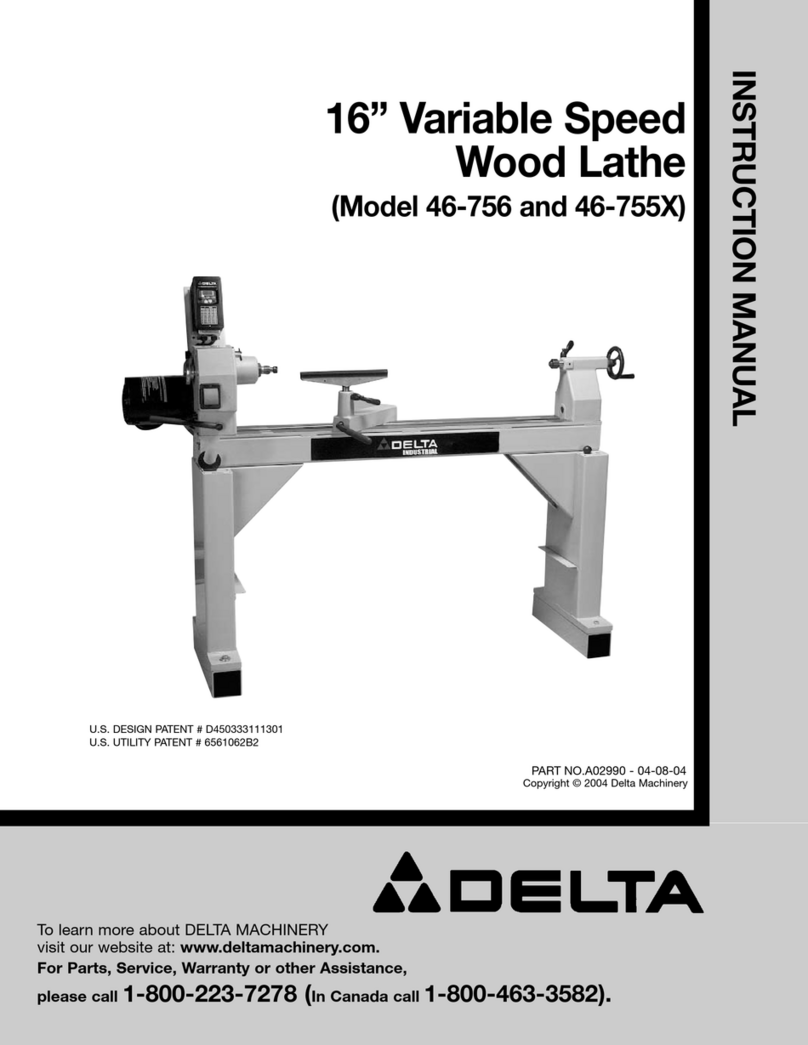
Delta
Delta 46-755X User manual
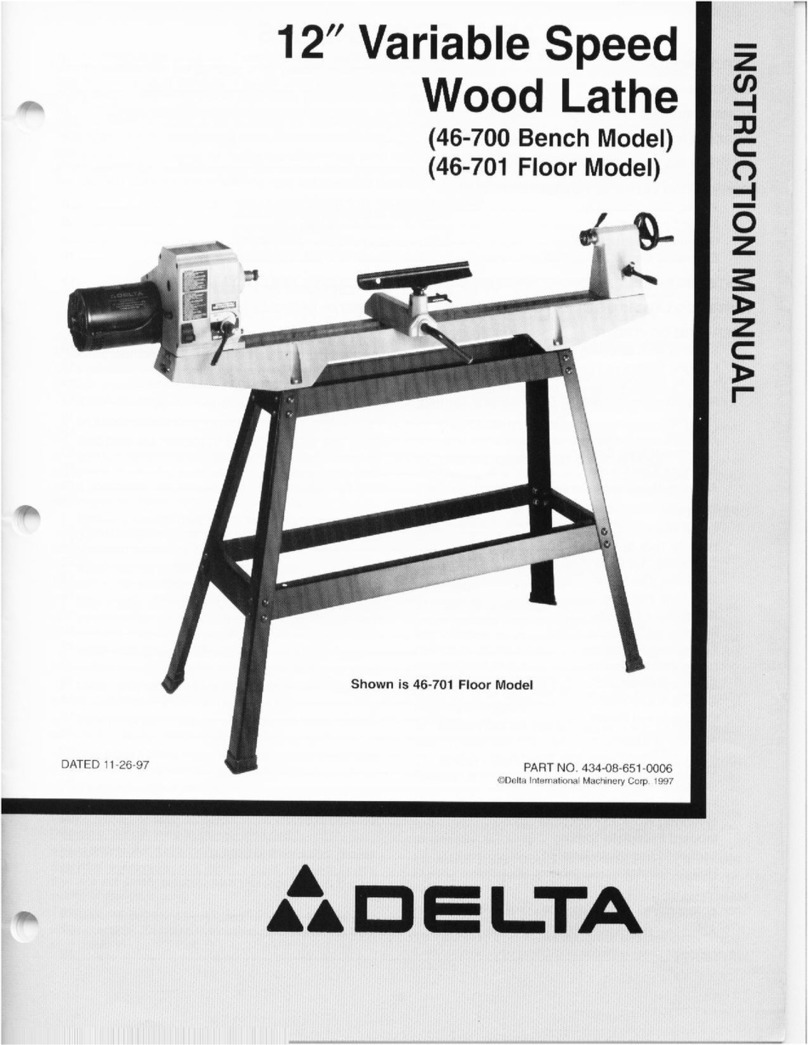
Delta
Delta 434-08-651-0006 User manual
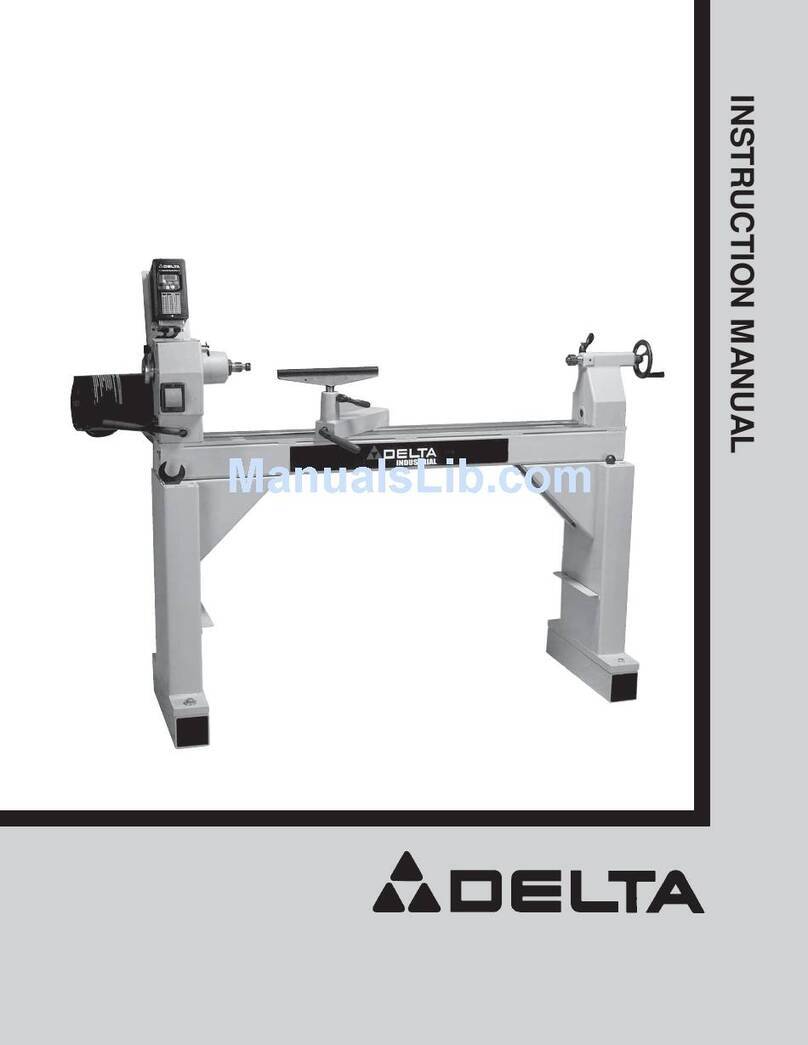
Delta
Delta 46-756 User manual

Delta
Delta 434-08-651-0001 User manual
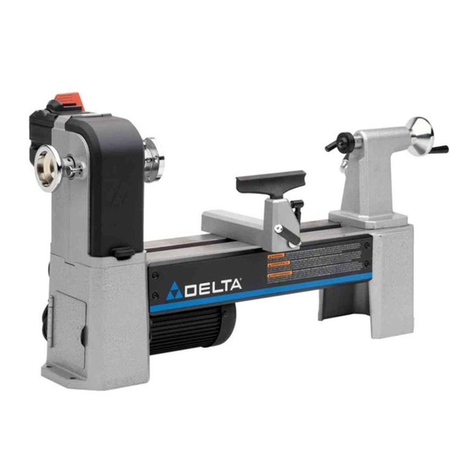
Delta
Delta 46-455 User manual
Popular Lathe manuals by other brands
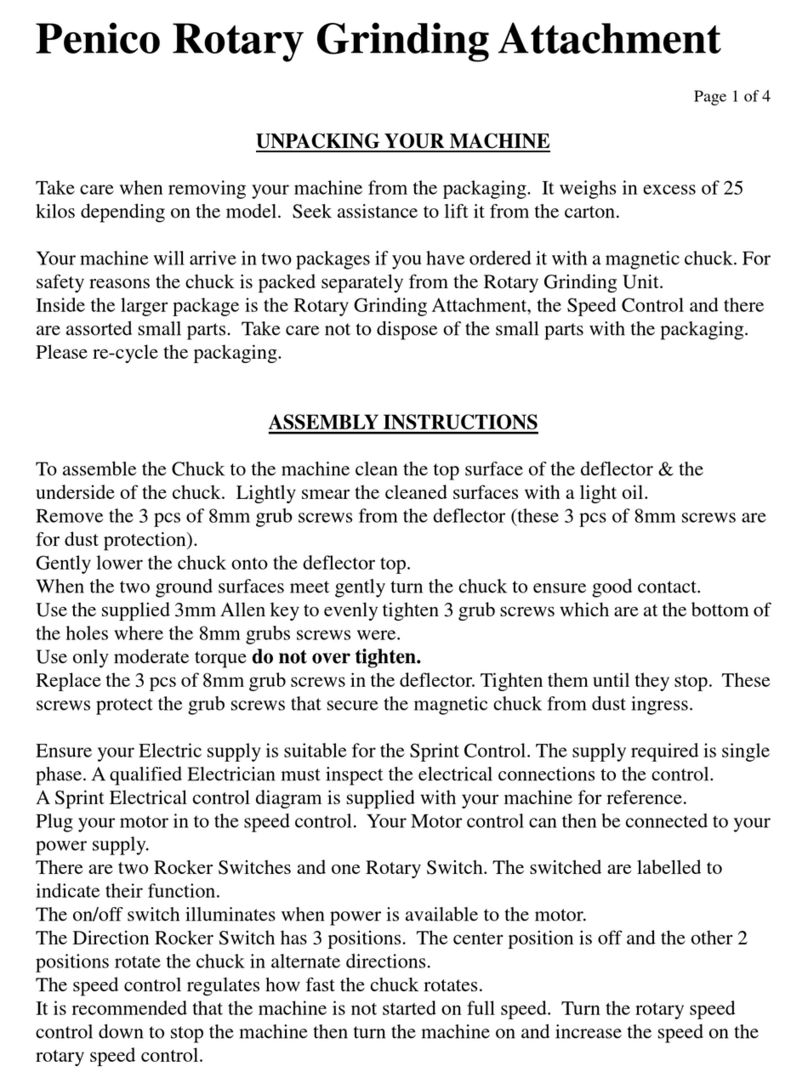
Penico
Penico Rotary Grinding Attachment manual
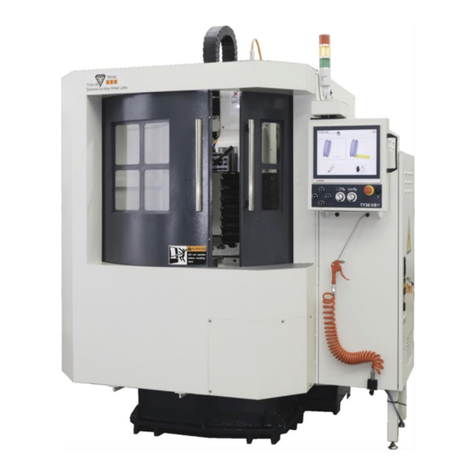
Tryax
Tryax TY30-VS Operation manual

Central Machinery
Central Machinery 33684 Assembly and operating instructions
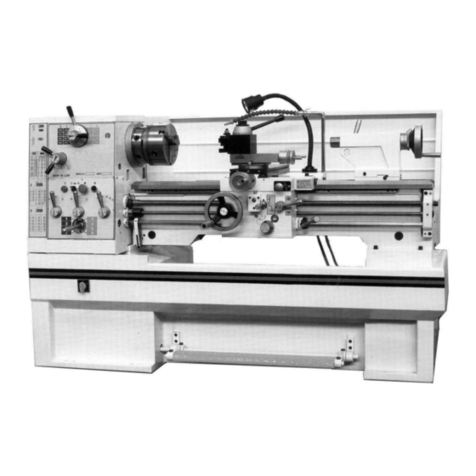
YANGZHOU SUPER MACHINE TOOL
YANGZHOU SUPER MACHINE TOOL CD6240 Instruction manual and parts list
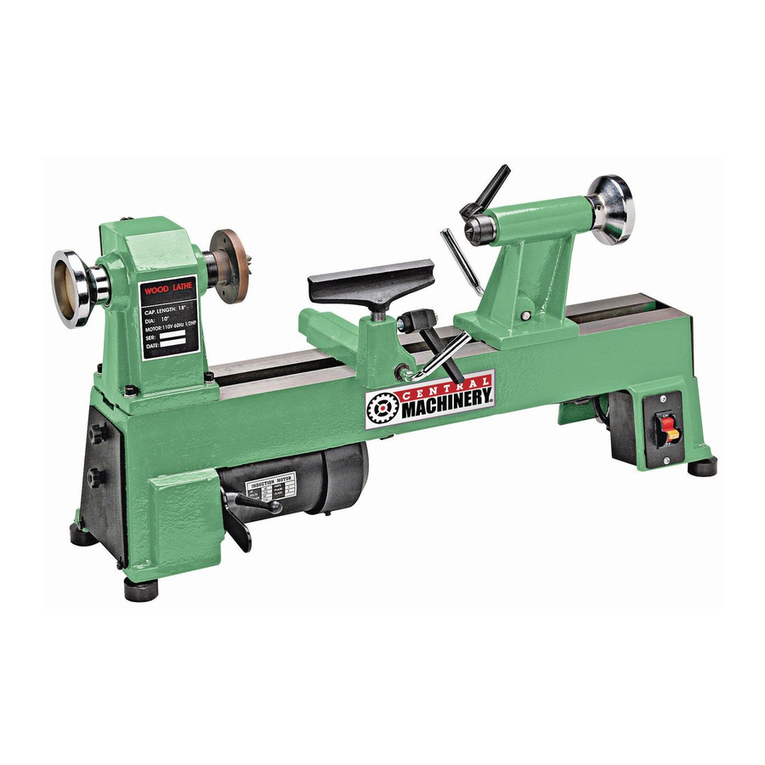
Central Machinery
Central Machinery CENTRAL MACHINERY 65345 Set up and operating instructions

Wadkin
Wadkin BZL operating instructions
